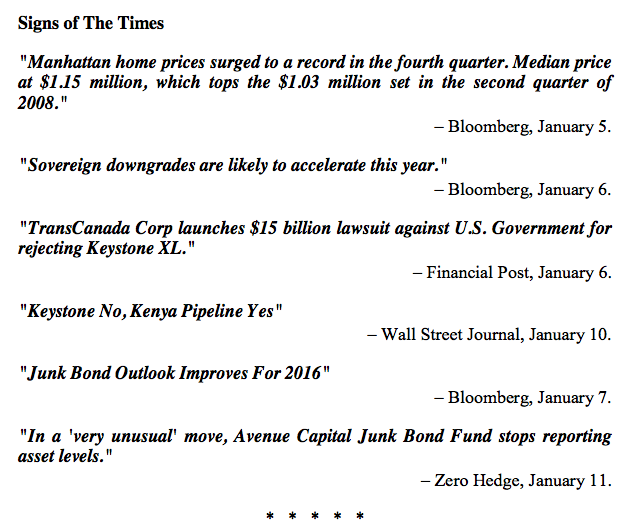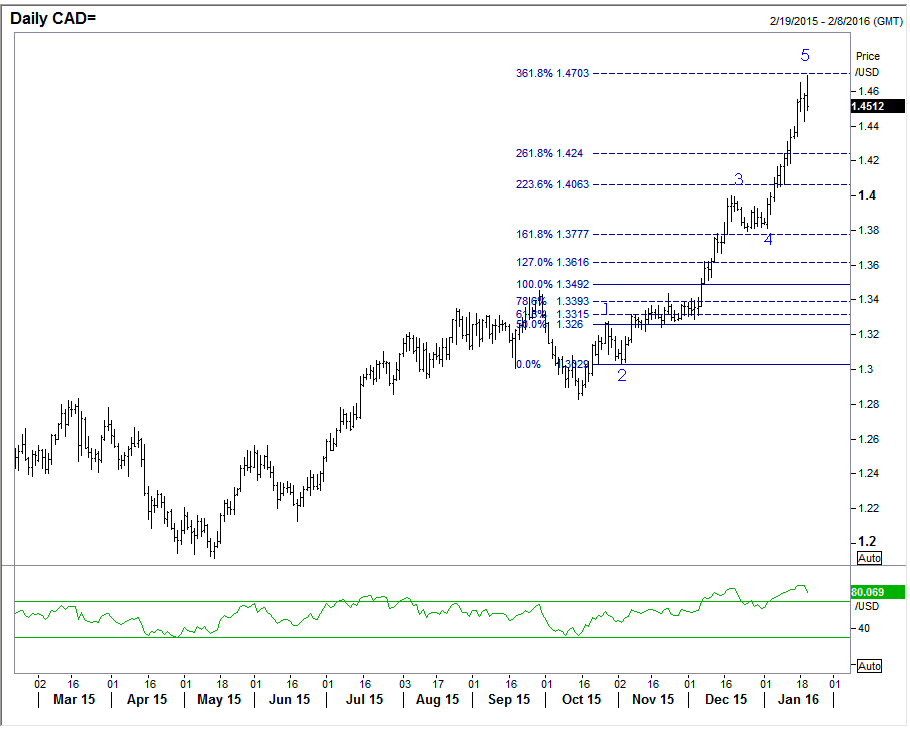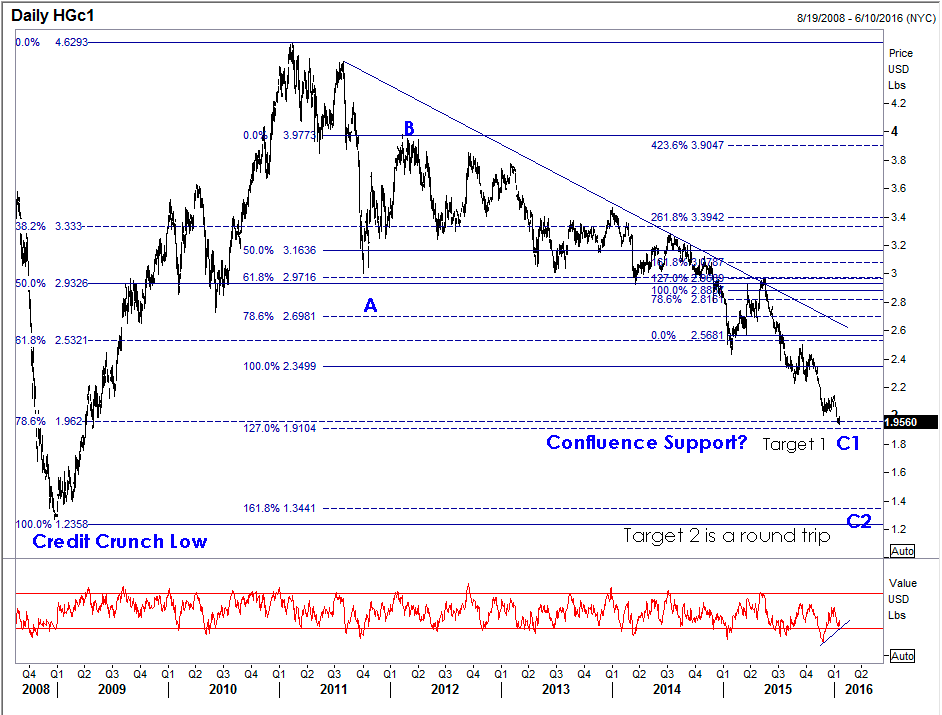Currency
Canada is the world’s fifth largest oil and gas producer and its energy export revenues are a significant part of the economy. In 2014, energy contributed 10% to Canada’s GDP, 28% of its export revenues were from energy products, and 97% of those energy exports were destined for US markets:

 Massive Reserve Hemorrhage
Massive Reserve Hemorrhage
China hemorrhaged $663 billion of its reserves since June 2014 in a misguided attempt to prop up the yaun. Once the biggest buyer of US treasuries China Starts Dumping U.S. Government Debt.
Note the irony of that headline. Misguided analysts long clung to the belief that the US dollar would go to hell when China started dumping treasuries, “certificates of confiscation” as they were commonly called.
Instead, China has used a significant portion of its reserves to prop up the Yuan. It still has about $3.3 trillion left according to estimates, but China cannot keep the current pace up forever.
“Temporary” Capital Controls the Solution?
The Financial Times reports Capital Controls May be China’s Only Real Option.
Chinese officials readily admit that communication has not been their strong point when it comes to dealing with international investors. Policymakers have now made it explicit that they have no wish to engineer a big devaluation. However, they are much less forthcoming about how they plan to reconcile a desire for currency stability with the realities of capital flight and a slowing economy.
Central bank guidance is most effective when the policy is clear and it is relatively straightforward to work out how it will evolve in response to changes in economic data. At present, the reality in China is that the PBoC has no clear course of action and wants to leave itself flexibility.
No amount of clarification would help to varnish the underlying problem: capital flight. The corruption clampdown and a lack of investment opportunities at home are driving Chinese people to take their money out of the country, just as the prospect of higher US interest rates is prompting companies to pay off dollar debt. Fear of a devaluation has fuelled the outflows. Far from seeking a weaker renminbi, the central bank has been forced to spend a big chunk of its reserves to prop it up
This goes against the grain of recent liberalising measures, which last year helped China win the renminbi’s inclusion in the International Monetary Fund’s special drawing rights basket, alongside traditional reserve currencies. However, the IMF has become far more willing to accept the case for temporary capital controls since quantitative easing sparked huge flows of hot money into emerging markets.
Capital controls are not a long-term solution but, at present, they are the correct step for Beijing to take in a very difficult situation. However, they will only work if China uses the breathing space to articulate a clear policy to rebalance its economy and liberalise its currency in the longer term — a process that will take many years.
Yuan’s Fall Is Just ‘Noise’ Amid Deeper China Woes
The Wall Street Journal hits the nail on the head with this headline: Yuan’s Fall Is Just ‘Noise’ Amid Deeper China Woes.
When the financier George Soros attacked the British pound in 1992 and famously “broke the Bank of England” he was trading on a conviction that the currency was misaligned.
Britain devalued after squandering its reserves in a vain defense. Mr. Soros walked off with $1 billion or more. To the surprise of many, though, the U.K. economy soon picked up once the pound found its proper level.
China’s raging battles with currency speculators are unlikely to end as happily for the country. That’s because turmoil in the currency markets reflects a much more perilous imbalance than an overvalued yuan: China is now lopsidedly dependent on ever larger inputs of local bank credit to keep sputtering growth from declining further.
The country is already littered with “zombie” factories, empty apartment blocks that form ghostly suburbs, mothballed power stations and other infrastructure that nobody needs. But yet more wasteful projects are in the pipeline, even as the government talks about cutting industrial overcapacity.
“That’s the misalignment–everything else is noise,” says Rodney Jones, the Beijing-based principal of Wigram Capital Advisors, who was a partner at Soros Fund Management during the 1990s.
If debt keeps piling up at the current rate, China faces an eventual financial crisis, perhaps leading to years of subpar growth, mirroring the fate of Japan after its bubble burst in the early 1990s.
Mr. Jones argues that global equity markets haven’t property adjusted to this risk, even after a 16% decline in U.S. dollar terms from their May peak. “The world will have to learn to live without demand from China,” he says. “It’ll come as a shock.”
Managing a Crisis of China’s Own Doing
As we sit here discussing “temporary” measures that often seem to last decades, we need to step back and ask: What caused this mess?
The answer is a ridiculous growth targets. To hit 7% growth targets for years on end, China had to waste a lot of money on projects, many of which are now worthless.
While the boom lasted, China, like Japan before it, was considered an “economic miracle”.
To top it off, China did not float the yuan, but now wants to defend an untenable target.
Unlike the above writers, I suggest China do what it should have done a decade ago: float the yuan and stop micro-managing the economy.
Sure there will be a lot of short term pain. But short term pain is a lot better than three lost decades as Japan is experiencing.
…more from Mike Shedlock:
Dallas Fed Region Activity Plunges to Lowest Reading Since 2009; Production Collapsed

Perspective
The year 2015 was remarkable. For the first time, a year with the ending in five number did not accomplish a gain. On the nearer-term, the Turn of the Year trade was the weakest in decades. It’s been widely reported that many hedge-fund strategies were not successful.
Beginning at Christmas last year, our research generally worked out. That includes the “Rotation” in commodities out to around May and then resumption of the bear market. Credit spreads were likely to be positive into June and then reverse to adversity.
The big event in equities was the Shanghai Bubble and collapse. While we did not forecast the Bubble, the work on its demise was reliable. In April the thrust was becoming compulsive and we noted that history suggested that it would climax in June.
Headlines that this year’s slump was forced by blunders by the guys running the Shanghai Exchange were inappropriate. Our comments have been that offers overwhelmed bids.
On the rebound out of the Shanghai Crash, the high-side of the ChartWorks target on the DJIA was a 100 points low. On the momentum target, the RSI number was almost met. Both were close enough.
Stock Markets
The headline on the latest slump was forced by blunders at the Shanghai Exchange. Our thoughts were that offers overwhelmed bids.
The hit was simple, but the stuff about limit-moves was complication. However, as with the hit in August, it was preceded by spread-widening. This time, spreads broke out on December 21st. The S&P fell through the 50 and 200-Day moving averages on December 29th. The SSEC fell through its 50-Day on December 31st.
The rally attempt by crude failed and in declining it forced spread-widening and another hit to most commodities.
All of which combined to record one of the worst opening weeks in history.1
Quite likely, that the year started badly has had little to do with the calendar, but more to do with seasonal weakness in crude oil and spread-widening. The latter can constrain stock market rallies.
As noted last week, the NYA had taken out the low closes back to October. This was enough to call it a bear. This also showed up in the All-World ex-US Index (VEU). The S&P has taken out the Shanghai-hit lows, but not back to the 2014 lows.
However, the Transports have been leading since April and the way has been down. TRAN took out the lows back to 2014 in early December. The European STOXX took out the August-September lows but not the ones in 2014.
As of today, BKX and XBD have taken out the lows back to 2014. Using the S&P, the US market is not oversold, and still precarious.
Currencies
With some swings, the Dollar Index is slowly rising with the 50-Day ma. Momentum is neutral and above the 100 level suggests a move to 109.
The Canadian dollar’s decline has steepened and at 69 is back to the levels of 2002. At 23 on the Weekly RSI it is getting oversold.
Credit Markets
The reversal to widening spreads triggered the setback in 2007. The second “breakout” in spreads marked the start of the severe contraction in 2008. We were watching for this in late July and it pushed off the infamous Shanghai liquidity crisis.
This time around, the second “breakout” (using the CCC spread) was accomplished on December 21st at 16.74 percentage points. It is now at 17.24, which is moving right along. The “breakout” in late July was at 10.57.
(The problem in Shanghai was more widening credit spreads than bureaucratic blunders at the exchange. Arbitrarily set limit moves did not prompt the selling.)
The extreme in the 2008 Crash was 44.20 percentage points.
This is our target. Once spreads set a new trend it becomes cyclically relentless.
The long bond (TLT) has rallied with each setback in the stock market and is doing it now. The rally from 119.67 in late December has made it to resistance at the 125 level. It is uncertain how far this can go.
Since June 2014 the advice has been to avoid lower-grade stuff and to position 3 to 4-year high-grade US corporates. The contribution from the US dollar has been outstanding.
Link to January 16, 2016 Bob Hoye interview on TalkDigitalNetwork.com:
https://www.youtube.com/watch?v=QAxXWas54pg&feature=youtu.be
Quotable
“There are more things in Heaven and Earth, Horatio, than are dreamt of in your philosophy.”
William Shakespeare, Hamlet
Commentary & Analysis
Seeing clearly…this would be an interesting place for a bounce…
What do I see here in the light of day?
- Global debt continues to rise and has reached levels once deemed dangerous
- Major economies are far from balanced: The G-4 (US, Japan, Germany, China)
- Global deflation is intensifying
- There are abundant supplies of oil
- Central banks are low on ammunition and ideas
- Davos and global elites in disbelief the serfs are no longer lapping up their political choices
- The fourth estate (media) power to shape events increasingly suspect
- Desire for tribe is more powerful than multicultural dreams and borders
- There is more to a business cycle than technology for technologies sake
I think I saw all of the above when stocks were climbing higher.
There is an old Sufi tale about a mullah (Nasruddin) who was discovered by a passer-by searching in the dust outside his house. What was he looking for, the stranger enquired. A key, said the mullah. Where did he drop it? “In the house” replied the mullah. Then why was he looking in the dust outside? Because here he was in bright sunlight, whereas in the house it was dark and difficult to see.
Taken from Way of the Dollar, John Percival
It would be a nice place for a bounce…three charts below:
USD/CAD Daily: The currency acted well today on news the Bank of Canada is to leave rates unchangedand adding the economy isn’t doing that badly. “The Bank now expects the economy’s return to above-potential growth to be delayed until the second quarter of 2016. The protracted process of reorientation towards non-resource activity is underway, helped by stronger U.S. demand, the lower Canadian dollar, and accommodative monetary and financial conditions. National employment remains resilient despite job losses in the resource sector and household spending continues to expand.”
Click here to view the PDF version with much larger charts
Key resistance at 1.4700…and an extension number to boot…

Copper Weekly: Coming into a long held extension target….1.9162-1.9104…

S&P 500 Index Daily: Key support tested…possible washout selling…

Incisive analysis it is not; but maybe something to think about.
Jack Crooks
President, Black Swan Capital
 People are grappling with market turmoil after Friday’s equity slide, but there was a good deal of action in another financial instrument: Bitcoin.
People are grappling with market turmoil after Friday’s equity slide, but there was a good deal of action in another financial instrument: Bitcoin.
Bitcoin moved down some 10 percent on Friday after one of its significant developers, Mike Hearn, claimed in a startling blogpost that the cryptocurrency was now a failure.
Hearn used a publishing platform, Medium, to make his announcement, writing, “Despite knowing that bitcoin could fail all along, the now inescapable conclusion that it has failed still saddens me greatly.”
Hearn’s views are reportedly aligned with Gavin Andresen, another famous developer. The controversy pits Hearn and Andresen against other developers over the issue of whether – and how – processing speed for bitcoin “blocks” should be expanded.














